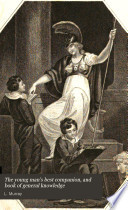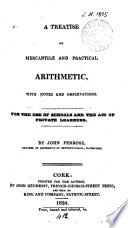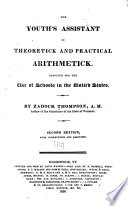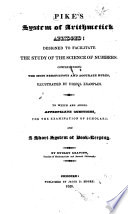 | Daniel Adams - Arithmetic - 1820 - 260 pages
...denominations to equivalent fractions having a common denominator. RULE. Multiply each numerator into all the denominators, except its own, for a new numerator, and all the denominators into each other, continually, for a common denominator. * Any whole number may be reduced to an improper... | |
 | L. Murray - 1821 - 620 pages
...to a common denominator. Rule.— Multiply the numerator of each fraction into all the denominator!! except its own, for a new numerator, and all the denominators together for ». common denominator. Example. Reduce J 2, and 4, of an integer to a common denominator. f. 3, ii=«•«•#•... | |
 | Thomas Keith - Arithmetic - 1822 - 354 pages
...be reduced to their proper terms by the preceding rules. Then, Rule I. Multiply each numerator into all the denominators, except its own, for a new numerator, and all the denominators together for a common denominator. OR II. 1. Multiply all the denominators of the given fraction together fof a common... | |
 | Beriah Stevens - Arithmetic - 1822 - 436 pages
...denominations to equivalent fractions, ha• ving a comm-in denominator. R:7LE. Multiply each numerator into all the denominators, except its own, for a new numerator, and all the denominators into each other, continually for a common denominator. EXAMPLES. s 1. Reduce f, f and f to equivalent... | |
 | James Mitchell - Mathematics - 1823 - 666 pages
...answer* as required. 4. To reduce fractions, having different denominators, to a common denominator. Multiply each numerator by all the denominators, except...new numerator ; and all the denominators together lor the common denominator; or Hind the least com* mon multiple of all the denominators, and multiply... | |
 | John Penrose (teacher of arithmetic.) - Arithmetic - 1824 - 320 pages
...— To reduce a compound fraction, to an equivalent simple one. Multiply all the numerators together for a new numerator, and all the denominators together for a new denominator, and the pro due ts will form the fraction required, If a part of the compound fraction or quantity... | |
 | Zadock Thompson - Arithmetic - 1826 - 176 pages
...denominators to equivalent fractions having a common denominator. RULE.! Multiply each numerator into all the denominators except its own for a new numerator, and all the denominators together for a common denominator. Examples. 1. Reduce J, ^ and f to a common denominator. 1 X3X4=12 new num. for... | |
 | Nicolas Pike, Dudley Leavitt - Arithmetic - 1826 - 214 pages
...denominators to equivalent fractions, having a common denominator. RULE. — Multiply each numerator into all the denominators, except its own, for a new numerator, and all the denominators into each other continually, for a common denominator. EXAMPLES. 1. Reduce J, f, and f to equivalent... | |
 | Roswell Chamberlain Smith - Arithmetic - 1826 - 114 pages
...to a common denominator? Ans. Multiply each numerator by all the denominators but the one under it, for a new numerator — and all the denominators together for a new denominator. What d you mean by a common denominator? Ans. When the denominators are all alike. Is the value altered... | |
 | Nicolas Pike, Dudley Leavitt - Arithmetic - 1826 - 222 pages
...denominators to equivalent fractionshavin a common denominator. RULE. — Multiply each numerator into all the denominators, except its own, for a new numerator, and all the denominators into each other continually, for a common denominator. EXAMPLES. 1. Reduce 1, f, and f to equivalent... | |
| |